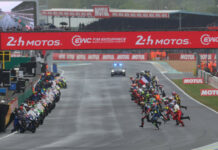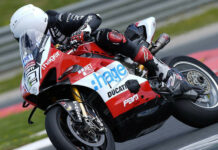First Ride: Aprilia RS 660 Introduction
Santa Barbara, California
Oct. 21, 2020
“There’s No Way This Thing Is Only A 660…”
by Michael Gougis
“There’s no way this thing is only a 660,” I thought when I first twisted the throttle on Aprilia’s new 2021 RS 660. We had just left the hotel to start a 160-mile test loop on the Italian company’s new parallel-twin middleweight, and the immediate impression of power didn’t diminish throughout the rest of the day.
The engine, with combustion chamber technology and design from the company’s stunning RSV4 line, pulls right off the bottom and increases in a linear manner all the way up to its indicated 11,500 rpm redline. Not only does it feel like it makes every one of its claimed 100 horsepower, but it also feels from the saddle like Aprilia’s claim of a wide, flat powerband was spot-on as well. About the only time you feel a bit of hesitation is when you roll on the throttle in sixth gear at low rpm. The mapping is faultless, and it just pulls slowly until the revs climb a bit, and then it’s suddenly not pulling slowly…
The image for Aprilia in the U.S. is based on performance, and the company knew it had to deliver a bike that felt like a performance bike, even though the middleweight twins category is populated with value oriented motorcycles with modest capabilities, machines that deliver more fun than thrills. This bike is fun, and it thrills, too. The RS 660’s personality centers around its engine. The intake roar is solid and throaty – the thing sounds the part of a performance bike. And the 659cc twin delivers on the promise of that engine note.
The RS 660 isn’t – and yet, is – a value-oriented machine. It’s more expensive by far than any other middleweight twin, but has so much more standard that to try to equip anything else in its class with this level of technology would end up costing you twice as much as this machine – or more.

For example, the bike comes with clutchless upshifting and downshifting, something that nothing else in its category has. Shifts up and down are positive and quick at the upper end of the rev range, while they can be a bit clunky at lower rpm. The bike comes with a slipper, assisted clutch with a light, precise pull for the few times you actually use it. It has cruise control. The headlights are wired to the bike’s central nervous system and direct light to the inside of the corners when riding at night.
You can take advantage of well-sorted electronics settings and just ride, or customize the settings down to a highly personal level. I just set the thing in the Dynamic mode and rode it there for the day, choosing to focus on other areas of the bike’s performance. In that setting, the anti-wheelie worked unobtrusively, softly cutting the power to set the front wheel back down. The brake feel is solid and linear, and the anti-lock system allows for a small stoppie while keeping the front wheel rotating and tracking true and straight.
One additional feature of the bike is that the rear turn indicators turn on in emergency flasher mode when you’re braking really hard – Aprilia wants the driver behind you to note that you’ve really jammed on the binders and are slowing rapidly. (Honestly, I’ve idly wondered why more vehicles don’t have some sort of deceleration rate indicator, rather than just a binary on/off brake light.)
The riding position is all-day perfect. The seat is broad and supportive except at the front, where it narrows to allow the rider to plant both feet on the ground. Because the swingarm is mounted to the engine cases, the chassis is narrower where the pegs are mounted, so they can be lower and still stay off the ground in enthusiastic cornering. The bars are just above the upper triple clamps, and it’s a short reach to them.
While some vibration gets through at certain rpm in the middle of the rev range, there is relatively little elsewhere, and the bar end weights and counterbalancer minimize even that. Overall, the riding position is compact and roomy at the same time. An aggressively shaped tank allows the rider to use a knee to lock themselves into position during aggressive cornering or braking.
The Thin-Film Transistor (TFT) dash was easy to see in the brightest of California sunshine, and it displayed everything I needed – revs, miles per hour, the gear selected. It took a little effort to fish through all the menus, but I suspect that had I read the owner’s manual, it would have been a lot simpler. There’s also a Race setting that displays things like a lap timer and activates a pit lane speed limiter.
There were two areas that I found lacking on this bike, one of six pre-production models built as of the test ride. (Here’s how important the U.S. market is to Aprilia: Of those six pre-production bikes, five were flown into the U.S. for journalists to ride and review.)
Neutral was occasionally hard to find. I’m willing to chalk that up to a bike that had only a few hundred miles on it and that was, indeed, a pre-production model.
The other area where improvements could be found was in the suspension. Front and rear Kayaba units, a single shock out back and 41mm inverted forks in the front, were adjustable for preload and rebound only, and the shock lacked any kind of external reservoir. When we were pushing on a bit on Highway 33 over the mountains east of Santa Barbara, the ride lacked the sophisticated control of better suspension components.
If I had to put a finger on it, I would suggest too much compression damping, far too little rebound and springs that felt too weak – and I’m a bit less than 170 pounds. Over some of the bumps and heaves, the rear felt like it rebounded so quickly that I was nearly bucked out of the seat. I know that Aprilia brought this machine in well under what the experts thought it would cost, at $11,299, but the bargain suspension components, I felt, were the limiting factor to how hard I wanted to push. Otherwise, the chassis felt amazing. On smoother corners, it just felt planted and stable, and flicking the bike through switchbacks really emphasized how little it weighed and drove home how little effort it took to ride.
Aprilia wanted to redefine the sportbike concept, expanding it beyond the four-cylinder configuration that is the contemporary norm. And it wanted a motorcycle that could be used on a daily basis, ridden a distance, and ridden hard.
I’d love to have one for a long-term evaluation, to take to the track and then to go visit friends in Seattle. But I can say this unequivocally: Aprilia has built a genuine performance machine.







